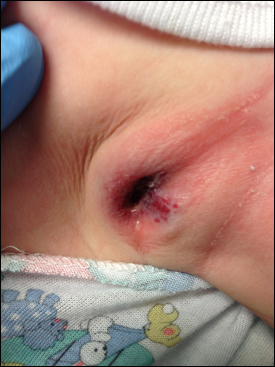Infant with left armpit lesion
An 11-week-old female presented to the ED for a lesion on her left armpit that was noted by her parents on the day of admission. The parents also reported some green discharge from the lesion and had not noticed any rash or lesion in the area prior. In hindsight, they felt that she seemed uncomfortable when that arm was handled and moved it less over the past 1 to 2 days.

Source: Pittalwala, R.
In the ED the patient was afebrile and well appearing. She had an irregular, ulcerated, well defined lesion about 1-cm wide, located deep inside the left axilla. There was some greenish discharge which later became bloody. Minimal sounding erythema was noted. There were no other skin lesions except mild scaling between the eyebrows. The patient was admitted and IV clindamycin was started.

Source: Pittalwala, R.
On careful exam of the lesion the next day the margins appears well demarcated with minimal surrounding erythema. There was some white and bloody discharge. Small 1-mm hemangiomatous papules were noted at the periphery of the ulcerative lesion. On the second day of admission the wound culture grew gram negative rods in addition to rare staphylococcia and IV cefotaxime was added while waiting further evaluation. The final wound culture grew rare coagulate negative staphylococci and rare Klebsiella pneumoniae.
What is the most likely etiology?
Diagnosis: Hemangioma with ulceration
Infectious disease was consulted and antibiotics were discontinued. The polymicrobial growth on wound surface culture was likely colonization in view of no systemic illness, minimal local inflammation on exam and normal white blood cell count and C-reactive protein. Therapy with oral propranolol was initiated with inpatient monitoring. She tolerated the therapy well and was discharged home on oral propranolol, topical mupirocin and Mepilex dressing. On followup at 6 weeks the hemangioma was decreased in size with superficial erosion.
This case was unusual as it presented in a location that may be overlooked on exam. It presented as an ulceration without previously known presence of hemangioma. The physical evidence for an underlying hemangioma was visible only on careful examination making it important to consider in the differential diagnosis.
Watchful waiting is appropriate for most uncomplicated hemangiomas as they involute spotaneously. Treatment is recommended based on rate of growth for lesions with potential to affect vital structures and those associated with ulceration and risk of disfigurement from scarring. Wound care, pain management and infection control are important for ulcerated hemangiomas especially in intertriginous areas prone to moisture and trauma. Barrier creams and non-stick dressings with topical antibiotics are recommended. Corticosteroids either topical, intralesional, or systemic were the mainstay of therapy.
Oral propranolol is a recommended therapy. It inhibits the growth of infantile hemangiomas and is now suggested as first line for ulcerated hemangiomas. A retrospective multicenter study concluded that it is safer and more effective than systemic glucocorticoids. A recent consensus report on use of propranolol for inantile hemangiomas outlines recommendations and contraindications for it's use and protocols for initiating treatment including indications for inpatient monitoring.
For more information:
- Up to date, Management of infantile hemangiomas. Accessed 3/26/2013.
- Initiation and Use of Propranolol for Infantile Hemangioma: Report of a Consensus Conference. Pediatrics 2013; 131:128.
- Propranolol vs corticosteroids for infantile hemangiomas: a multicenter retrospective analysis. Arch Dermatol 2011; 147:1371.
Disclosure: Pittalwala reports no relevant financial disclosures.
